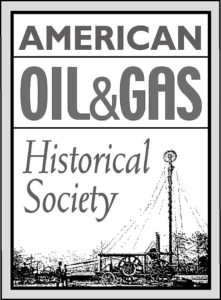by Bruce Wells | Jun 9, 2025 | This Week in Petroleum History
June 9, 1894 – Water Well finds Oil in Corsicana, Texas –
A contractor hired by the town of Corsicana to drill a water well on 12th Street found oil instead, launching the Texas petroleum industry seven years before the more famous Spindletop Hill gusher hundreds of miles to the southeast. Corsicana’s well produced just 2.5 barrels of oil a day from a depth of 1,035 feet, but inspired a rush of exploration companies.
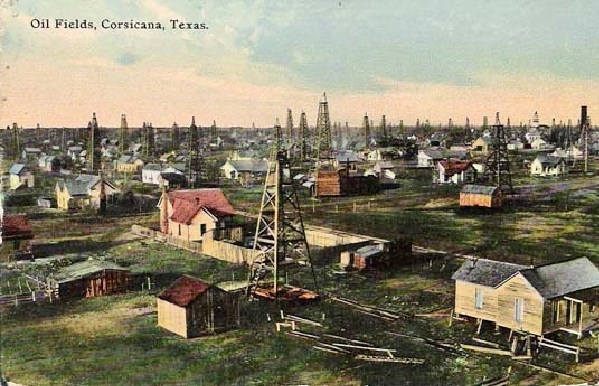
A colorized postcard depicts the Corsicana oilfield circa 1910. The boom town, which became an oilfield service and manufacturing center, today annually celebrates its oil patch heritage.
By 1898, about 300 produced oil in and around the boom town, which also became a center for technological innovation. A Corsicana company patented and manufactured the rotary rig that drilled the 1901 Spindletop discovery well near Beaumont.
Despite Corsicana’s oilfield discovery well bringing petroleum riches and a drilling boom, city officials paid the contractor only half of the $1,000 fee, citing the agreement for completing a water well. Corsicana has hosted an annual Derrick Days since 1976.
Learn more in First Texas Oil Boom.
June 9, 2023 — California Pump Jack added to Historic Register
An eccentric-wheel oilfield pumping unit that operated in California’s largest oilfield joined the National Register of Historic Places, thanks to research by Mark Smith, who submitted the application. Installed by the Engineers Oil Company in 1913, the Kern County jack plant’s eccentric wheels pumped oil until 1990.

In operation until 1990, California’s Midway-Sunset Jack Plant used eccentric-wheel technologies from the late 19th century. The Kern County plant pumped more than 1.5 million barrels of oil. Photos courtesy John Harte. Illustration courtesy San Joaquin Geological Society.
“The Midway-Sunset Jack Plant is an extremely rare example of central power and ‘jack-line’ oil pumping technology on its original site and housed in its original building,” Smith noted in his 45-page draft application to the State Historical Resources Commission and later approved by the National Park Service. “Its design and operational history reflect significant advancements in oil extraction technology.”

June 11, 1816 – Manufactured Gas lights Art Museum in Baltimore
The first commercial gas lighting of residences, streets and businesses began when Rembrandt Peale impressed Baltimore civic leaders by illuminating a room in his Holliday Street Museum by burning “manufactured gas.” His display (using gas distilled from coal, tar or wood) dazzled them with a “ring beset with gems of light.”
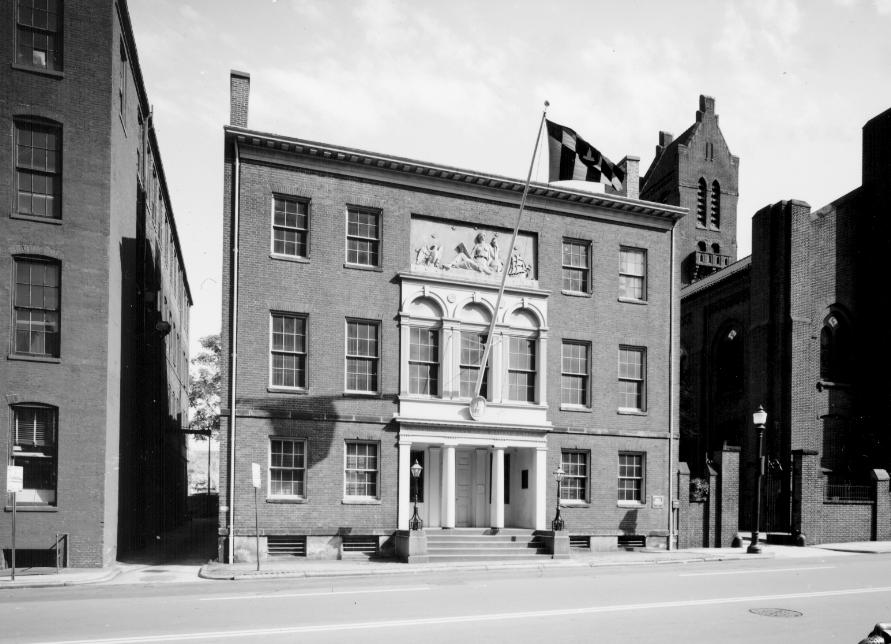
Lighted with manufactured gas, this Baltimore museum opened in 1814, America’s first building erected as a museum. Photo courtesy Maryland Historical Trust.
The Baltimore museum became the first U.S. public building to use gas lighting, according to the Maryland Historical Trust. Within a week, the city council approved plans to illuminate the city’s streets. Peale and a group of investors founded the Gas Light Company of Baltimore — the first gas company in America (today Baltimore Gas and Electric).
Learn more about “town gas” in Illuminating Gaslight.
June 11, 1911 – E.W. Marland discovers Ponca Nation Oilfield
Ernest W. Marland, founder of the 101 Ranch Oil Company in 1908, discovered an oilfield near Ponca City, Oklahoma, after reorganizing the company in his hometown of Pittsburgh, Pennsylvania. Almost broke after drilling eight uneconomical wells, Marland had turned to childhood friend John McCaskey of Pittsburgh, known as the “Sauerkraut King.”

Circa 1910 newspaper promotion of the 101 Ranch Oil Company following discoveries near Ponca (City), west of Osage Nation leases and oilfields.
Partnered with McCaskey and the owners of the 101 Ranch, Marland received permission from White Eagle, chief of the Ponca Nation, to drill near a reservation burial ground. The oilfield discovery well and many that followed produced oil on a reservation allotment owned by Willie-Cries-For-War, age 19, who had leased his 160 acres to Marland for $1,000 a year and 12.5 cents a barrel of oil produced.
Marland would found Marland Oil Company in 1917, merge it with Continental Oil in 1928, and become governor of Oklahoma in 1935. ConocoPhillips opened a Conoco Museum in Ponca City in 2007.
June 11, 1929 – Independent Producers get Organized
Ninety-five years ago, Wirt Franklin of Ardmore, Oklahoma, spoke on behalf of small exploration and production companies during President Herbert Hoover’s Oil Conservation Conference at the Broadmoor Hotel in Colorado Springs, Colorado. Franklin and other independent producers opposed creating a federal commission that could restrict production and allow more imported foreign oil.
“If this condition should be brought about, it would mean the annihilation and destruction of the small producer of crude oil, ” proclaimed Franklin, who had found success in the shallow but prolific Healdton oilfield. Before returning to Ardmore, Franklin and other independents established today’s Washington, D.C.-based Independent Petroleum Association of America (IPAA).

June 12, 1879 – Allegheny Oilfield discovered by O.P. Taylor
Orville “O.P.” Taylor completed the Triangle No. 1 well at a depth of 1,177 feet in Allegheny County, New York, revealing an oilfield that extended into Pennsylvania. His discovery came after two failed wells drilled near oil seeps first reported by a French missionary in 1627. O.P.’s Allegheny oilfield launched a drilling boom that created the town of Petrolia.
The Confederate Army veteran had worked in the cigar manufacturing business in Virginia before catching “oil fever” after reading of oil discoveries along the Allegheny River (see Derricks of Triumph Hill). Early success led to his election as mayor of Wellsville, New York, and the title of “Father of the Allegheny Oilfield.” A Liberty Ship would be named for him during World War II.
June 13, 1917 – Phillips Petroleum Company founded
During the early months of America’s entry into World War I, as oil prices rose above $1 per barrel, Phillips Petroleum Company was founded in Bartlesville, Oklahoma. Brothers Frank and Lee Eldas “L.E.” Phillips consolidated their oil companies and began operating throughout Oklahoma and Kansas. Assets rose from $3 million to $100 million within a few years.

Brothers L.E. Phillips (left) and Frank Phillips established Phillips Petroleum Company in Bartlesville in 1917. Photo courtesy ConocoPhillips.
In 1927, Phillips Petroleum began selling its gasoline in Wichita, Kansas, the first of more than 10,000 Phillips 66 service stations. Phillips chemists received thousands of U.S. patents, including one in 1954 for Marlex, a high-density polyethylene. Wham-O toy company was the first to buy the new plastic (see Petroleum Product Hoopla). The oil company’s high-octane Nu-Aviation fuel played an important role in winning World War II.
Phillips Petroleum merged with Conoco in 2002 to become ConocoPhillips, which in 2007 established petroleum museums in Ponca City and Bartlesville as part of the 100th anniversary of Oklahoma statehood.
June 13, 1928 – Hobbs Oilfield discovered in New Mexico
The New Mexico petroleum industry was launched with the discovery of the Hobbs oilfield near the southeastern corner of the state. After months of difficult cable-tool drilling, the Midwest State No. 1 well produced oil for the Midwest Refining Company, which had drilled the state’s first oil well in 1922.
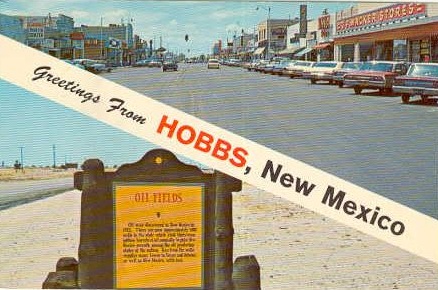
A June 1928 oilfield discovery brought many decades of petroleum prosperity to downtown Hobbs, New Mexico.
The Hobbs well revealed a giant field, later cited by the New Mexico Bureau of Mines & Mineral Resources as “the most important single discovery of oil in New Mexico’s history.” But after months of drilling, the well had reached a depth of 1,500 feet when an engine house fire consumed the wooden derrick. “Men with less vision would have given up, but not the drillers of Midwest,” noted the state geologist.
As the Great Depression approached, oil production from the Hobbs field attracted investors and drilling companies, quickly transforming Hobbs from “sand, mesquite, bear grass and jackrabbits” to the fastest-growing town in the nation.
Learn more in First New Mexico Oil Wells.

June 14, 1865 – First Daily Oil Region Newspaper
Pennsylvania’s oil region got its first daily newspaper when brothers William and Henry Bloss published a four-page broadsheet, which exceeded a circulation of 300 as the Titusville Herald. The first edition’s articles included a reference to John Wilkes Booth’s visits to the region and his August 1864 oil interests.

The “First Daily Newspaper in the Pennsylvania Oil Region” noted John Wilkes Booth’s petroleum interests.
“John Wilkes Booth purchased a one-thirteenth interest in the territory in August 1864,” the newspaper reported. “We are credibly informed that this Homestead well (see Dramatic Oil Company) in which Booth was interested was destroyed by fire on the day he assassinated President Lincoln.”
June 14, 1938 – United States regulates Natural Gas
The federal government for the first time assumed regulatory control of U.S. natural gas sales to limit the growing market power of interstate pipeline companies.
Although the Natural Gas Act of 1938 did not apply to production, gathering or local distribution, it sought to establish “just and reasonable rates” for pipeline company transmission or sales of natural gas in interstate commerce. Regulatory functions were assigned to the Federal Power Commission (established in 1920), which became the Federal Energy Regulatory Commission (FERC) in 1977.
June 15, 1954 – Launch of First Mobile Offshore Rig
The offshore barge oil drilling platform, Mr. Charlie left its Louisiana shipyard and went to work for Shell Oil Company in a new oilfield in East Bay, near the mouth of the Mississippi River. The vessel’s design, which would revolutionize the offshore industry, originated with Alden “Doc” Laborde, a marine superintendent for the Kerr-McGee Company in Morgan City, Louisiana.
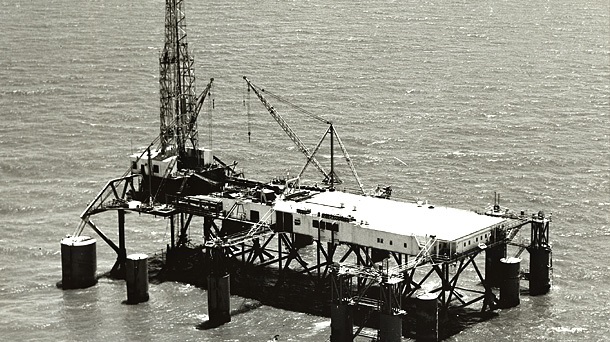
Beginning in 1954 and capable of drilling wells in water up to 40 feet in depth, Mr. Charlie became the first mobile offshore drilling unit (MODU). Photos courtesy Murphy Oil Corp.
Despite Kerr-McGee’s experience with many post-World War II offshore technologies, including drilling the first oil well out of sight of land in 1947, the company decided against Laborde’s idea for a transportable, submersible drilling barge. The inventor, a Navy veteran, eventually found support from Charles Murphy Jr., founder of Murphy Oil Company.

A self-sufficient drilling rig on a barge, Mr. Charlie in 1954 became an offshore technology milestone with its transportable, column-stabilized design.
LaBorde established Ocean Drilling & Exploration and contracted with J. Ray McDermott Company to convert a 220-foot barge into a drilling platform — the world’s first mobile offshore drilling unit (MODU). Today moored in Morgan City as an international petroleum museum, in December 2024 the Secretary of the Interior added Mr. Charlie to the National Register of Historic Places.
Learn more in Mr. Charlie, First Mobile Offshore Drilling Rig.
_______________________
Recommended Reading: Corsicana (2010); Texas Oil and Gas Postcard History (2013); Black Gold in California: The Story of California Petroleum Industry  (2016); In Pursuit of Fame: Rembrandt Peale, 1778-1860 (1993); The Extraction State, A History of Natural Gas in America (2021); Oil And Gas In Oklahoma: Petroleum Geology In Oklahoma
(2016); In Pursuit of Fame: Rembrandt Peale, 1778-1860 (1993); The Extraction State, A History of Natural Gas in America (2021); Oil And Gas In Oklahoma: Petroleum Geology In Oklahoma (2013); Oil Man: The Story of Frank Phillips and the Birth of Phillips Petroleum
(2013); Oil Man: The Story of Frank Phillips and the Birth of Phillips Petroleum (2014); Oil in West Texas and New Mexico
(2014); Oil in West Texas and New Mexico (1982); Around Titusville, Pa., Images of America
(1982); Around Titusville, Pa., Images of America (2004); Offshore Pioneers: Brown & Root and the History of Offshore Oil and Gas
(2004); Offshore Pioneers: Brown & Root and the History of Offshore Oil and Gas (2011); Breaking the Gas Ceiling: Women in the Offshore Oil and Gas Industry (2019);. Your Amazon purchase benefits the American Oil & Gas Historical Society. As an Amazon Associate, AOGHS earns a commission from qualifying purchases.
(2011); Breaking the Gas Ceiling: Women in the Offshore Oil and Gas Industry (2019);. Your Amazon purchase benefits the American Oil & Gas Historical Society. As an Amazon Associate, AOGHS earns a commission from qualifying purchases.
_______________________
The American Oil & Gas Historical Society (AOGHS) preserves U.S. petroleum history. Please become an AOGHS annual supporter and help maintain this energy education website and expand historical research. For more information, contact bawells@aoghs.org. Copyright © 2025 Bruce A. Wells. All rights reserved.
by Bruce Wells | Apr 14, 2025 | This Week in Petroleum History
April 14, 1865 – Failed Oilman turns Assassin –
After failing to make his fortune in Pennsylvania oilfields, John Wilkes Booth assassinated President Abraham Lincoln in Washington, D.C. Booth had left his acting career a year earlier to drill an oil well in booming Venango County.
In January 1864, Booth visited Franklin, Pennsylvania, where he leased 3.5 acres on a farm, about one mile south of the village of Franklin and on the east side of the Allegheny River. With several partners, including his friends from the stage, Booth formed the Dramatic Oil Company and raised money to drill a well.
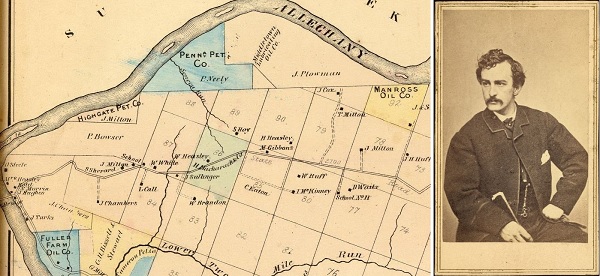
John Wilkes Booth made his first trip to the oil boom town of Franklin, Pennsylvania, in January 1864. He purchased a 3.5-acre lease on the Fuller farm (lower left). Circa 1865 photo of Booth by Alexander Gardner, courtesy Library of Congress.
Although the Dramatic Oil Company’s well found oil and began producing about 25 barrels a day, Booth and his partners wanted more and tried “shooting” the well to increase production. When the well was ruined, the failed oilman left the Pennsylvania oil region for good in July 1864.
Learn more in Dramatic Oil Company.
April 14, 1903 – Patent for Self-Heating Iron fueled by Gasoline
John Lake of Big Prairie, Ohio, received a U.S. patent (No. 725,261) for his gasoline-fueled “Self-Heating Sad Iron.” Lake had served in the 16th Ohio Volunteer Infantry Regiment during the Civil War. The ironing innovation for homes brought prosperity to his Amish community, where he established the Monitor Sad Iron Company on the Pennsylvania Railroad line. His manufacturing company made the petroleum-fueled irons for the next 50 years.
Learn more in Ironing with Gasoline.
April 15, 1857 – First Natural Gas Company incorporated
Two years before the first U.S. oil well in Titusville, Pennsylvania, the Fredonia Gas Light and Water Works Company incorporated in Fredonia, New York, where a well drilled by local machinist and gunsmith William A. Hart supplied natural gas to a mill as early as 1825. Hart found the gas after drilling three wells, according to historian Lois Barris.
“He left a broken drill in one shallow hole and abandoned a second site at a depth of forty feet because of the small volume of gas found,” Barris noted in her “Fredonia Gaslight and Waterworks Company.”
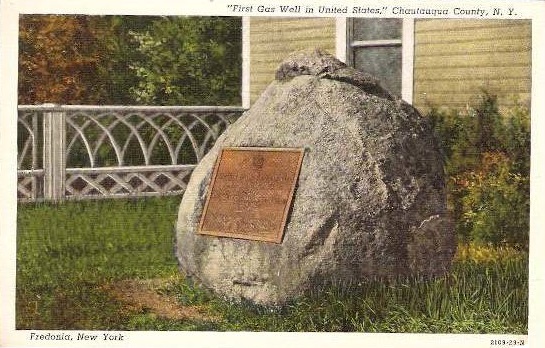
Circa 1950 souvenir postcard of a bronze plaque on a boulder in Fredonia, New York, dedicated in 1925 by the Daughters of the American Revolution.
Hart’s third well produced natural gas from 70 feet beneath a “bubbling gas spring in the bed of a creek,” Barris reported, adding that after constructing a simple gasometer, he “proceeded to pipe and market the first natural gas sold in this country.”
As other communities adopted public lighting burning gas made from coal (manufactured gas street lamps began illuminating Baltimore in 1817), Fredonia Gas Light and Water Works built the first U.S. natural gas pipeline network.

April 15, 1897 – Birth of Oklahoma Oil Industry
With a crowd gathered at the Nellie Johnstone No. 1 well near Bartlesville in Indian Territory, George Keeler’s stepdaughter dropped a “Go Devil” that set off a downhole canister of nitroglycerin. The resulting gusher heralded the start of Oklahoma’s oil and natural gas industry.
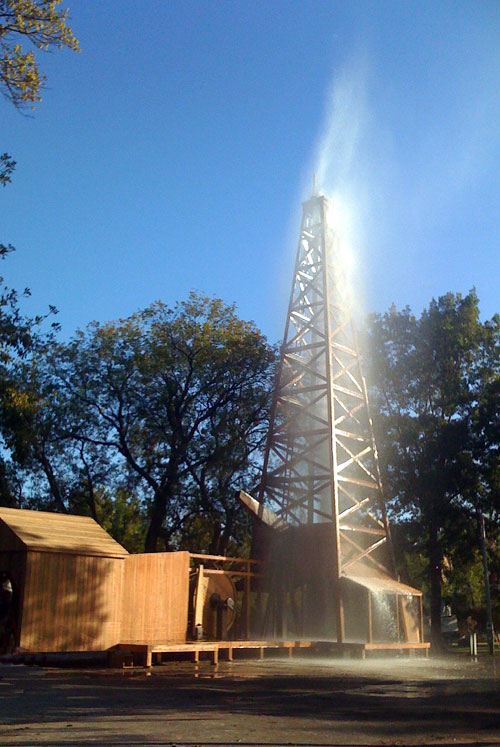
A 2017 water gusher demonstration of the Nellie Johnstone No. 1 replica in Discovery One Park, Bartlesville, Oklahoma.
Drilling had begun in January 1897, the same month that Bartlesville incorporated with a population of about 200 people. Four months later, at 1,320 feet, the Nellie Johnstone No.1 well showed its first signs of oil. There had been earlier marginal producers, including a Cherokee Nation 1890 oil well; the Johnstone well revealed the giant Bartlesville-Dewey field.
By the time of statehood in 1907, Oklahoma would lead the world in oil production. An 84-foot derrick in Discovery One Park helps educate visitors about Oklahoma’s petroleum industry. The surrounding land was donated by Nellie Johnstone Cannon, the descendant of a Delaware chief.
Learn more in First Oklahoma Oil Well.
April 16, 1855 – Scientist sees Value in “Rock Oil”
Yale chemist Benjamin Silliman Jr. reported Pennsylvania “Rock Oil” could be distilled into a high-quality illuminating oil. The professor’s “Report on Rock Oil or Petroleum” convinced a businessman George Bissell and a group of New Haven, Connecticut, investors to finance Edwin Drake to drill where Bissell had found oil seeps at a creek in northwestern Pennsylvania.
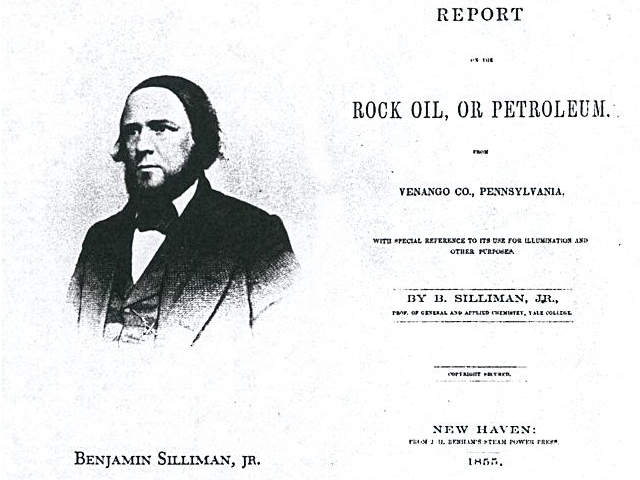
The Yale chemist’s 1855 report about oil’s potential for refining as an illuminant led to America’s first commercial well four years later.
“Gentlemen,” Silliman wrote, “it appears to me that there is much ground for encouragement in the belief that your company have in their possession a raw material from which, by simple and not expensive processes, they may manufacture very valuable products.”
Learn more in George Bissell’s Oil Seeps.
April 16, 1920 – First Arkansas Oil Well
Col. Samuel S. Hunter of the Hunter Oil Company of Shreveport, Louisiana, completed the first oil well in Arkansas. His Hunter No. 1 well had been drilled to 2,100 feet. Natural gas was discovered a few days later by Constantine Oil and Refining Company north of what would become the El Dorado field in Union County.
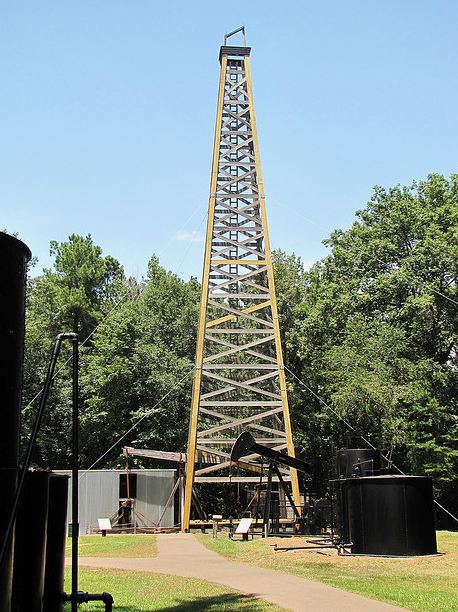
The Arkansas Museum of Natural Resources is just north of El Dorado.
Although Col. Hunter’s oil well yielded only small quantities, his discovery was followed by a January 1921 gusher — the S.T. Busey well — in the same field. These wells made headlines and launched the Arkansas petroleum industry, according to the Arkansas Museum of Natural Resources. Hunter later sold his original lease of 20,000 acres to the Standard Oil Company of Louisiana for more than $2.2 million.
Learn more in First Arkansas Oil Wells.

April 17, 1861 – Deadly Oil Well Fire in Pennsylvania
The lack of technologies for controlling wells led to a fatal oil well fire at Rouseville, Pennsylvania. Among the 19 people killed was leading citizen Henry Rouse, who subleased the land along Oil Creek. When his well erupted oil from a depth of 320 feet, the good news had attracted most Rouseville residents. “Henry Rouse and the others stood by wondering how to control the phenomenon,” noted the local newspaper. Then the gusher erupted into flames, perhaps ignited by a steam-engine boiler.
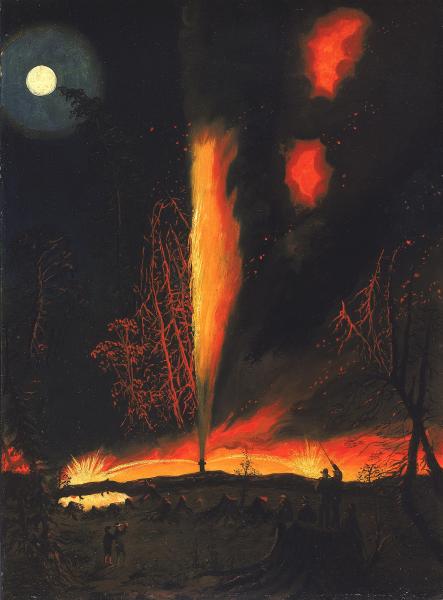
“Burning Oil Well at Night, near Rouseville, Pennsylvania,” a painting by James Hamilton, circa 1861, at the Smithsonian American Art Museum, Washington, D.C.
The oilfield tragedy near Titusville would be overshadowed by the Civil War, but it was immortalized in 1861 by Philadelphia artist James Hamilton’s “Burning Oil Well at Night, near Rouseville, Pennsylvania,” which was added to the Smithsonian American Art Museum collection in 2017.
Learn more in Fatal 1861 Rouseville Oil Well Fire.
April 17, 1919 – North Texas Burkburnett Boom grows
Yet another drilling boom began in Wichita County, Texas, when the Bob Waggoner Well No. 1 well began producing 4,800 barrels of oil a day — extending to the northwest a 1918 oilfield found on the Burkburnett farm of S.L. Fowler. Wichita County had been producing oil since the 1911 discovery of the Electra oilfield.
At Burkburnett, a 2006 historical marker of the Texas Historical Commission notes the 1919 discovery “became known as the Northwest Extension Oilfield, comprised of approximately 27 square miles on the former S. Burk Burnett Wild Horse Ranch.” The marker adds “the area was suddenly thick with oil derricks” thanks to the oilfield discoveries that created the boom town Burkburnett.
April 18, 1939 – Patent for perforating Well Casing
Ira McCullough of Los Angeles patented a multiple bullet-shot casing perforator and mechanical firing system. He explained the object of his oilfield invention was “to provide a device for perforating casing after it has been installed in a well in which projectiles or perforating elements are shot through the casing and into the formation.”
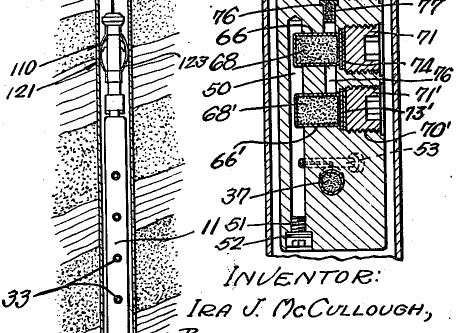
Ira McCullough’s 1937 patent drawing for perforating wells.
The innovation of simultaneous firing from several levels in the borehole greatly enhanced the flow of oil. McCullough’s device included a “disconnectable means” that rendered percussion inoperative until the charges were lowered into the borehole, acting as “a safeguard against accidental or inadvertent operation.”
Another inventor, Henry Mohaupt, in 1951 used anti-tank technology from World War II to improve the concept by using a conically hollowed-out explosive for perforating wells.
Learn more in Downhole Bazooka.
April 19, 1892 – First U.S. Gasoline Powered Automobile
Brothers Charles and Frank Duryea test drove a gasoline-powered automobile they had built in their Springfield, Massachusetts, workshop. Considered the first model to be regularly manufactured for sale in the United States, 13 were produced by the Duryea Motor Wagon Company.
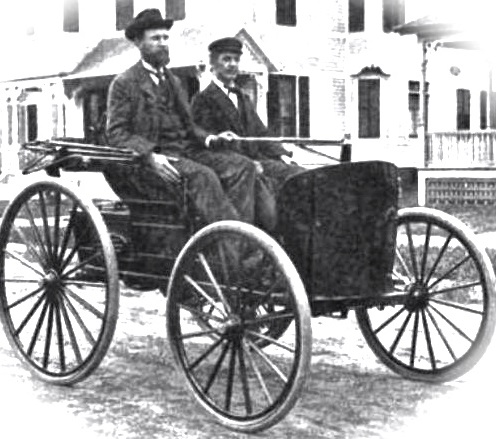
The Duryea brothers (above) built their pioneering autos in Springfield, Massachusetts.
The brothers sold their first Duryea motor wagon in March 1918. Two months later, a motorist driving a Duryea in New York City hit a bicyclist — reportedly America’s first auto traffic accident. By the time of the first U.S. automobile show in November 1900 at Madison Square Garden, of the 4,200 automobiles sold in the United States, gasoline powers less than 1,000.

April 20, 1875 – Improved Well Pumping Technology
Pumping multiple wells with a single steam engine boosted efficiency in early oilfields when Albert Nickerson and Levi Streeter of Venango County, Pennsylvania, patented their “Improvement In Means For Pumping Wells.” The new technology used a system of linked and balanced walking beams to pump oil wells.

U.S. oilfield technologies advanced in 1875 with an “Improvement In Means For Pumping Wells.”
“By an examination of the drawing it will be seen that the walking-beam to well No. l is lifting or raising fluid from the well. Well No. 3 is also lifting, while at the same time wells 2 and 4 are moving in an opposite direction, or plunging, and vice versa,” the inventors explained. Their system was the forerunner of rod-line (or jerk-line) eccentric wheel systems that operated into the 20th century using iron rods instead of rope and pulleys.
Learn more in All Pumped Up – Oilfield Technology.
April 20, 1892 – Prospector discovers Los Angeles City Oilfield
The giant Los Angeles oilfield was discovered when a struggling prospector, Edward Doheny, and his mining partner Charles Canfield drilled into the tar seeps between Beverly Boulevard and Colton Avenue. Their well produced about 45 barrels of oil a day.
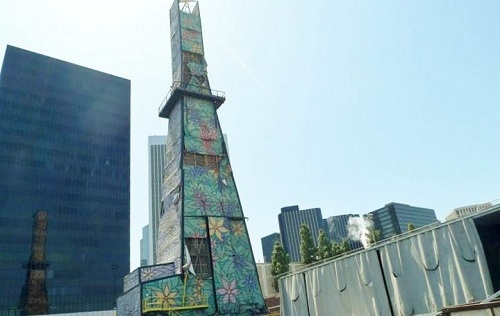
Artfully camouflaged petroleum production continues today in downtown Los Angeles. Edward Doheny discovered the oilfield in 1892. Photo courtesy the Center for Land Use Interpretation, Culver City, California.
Although the first California oil well had been drilled after the Civil War, Doheny’s 1892 discovery near present-day Dodger Stadium launched California’s petroleum industry. In 1897, about 500 Los Angeles City wells pumped more than half of the state’s annual production of 1.2 million barrels of oil. By 1925, California supplied half of all the world’s oil.
Learn more in Discovering Los Angeles Oilfields.
April 20, 2010 – Deepwater Horizon Gulf of Mexico Disaster
At 10 a.m., while completing a well in the Macondo Prospect, 50 miles off the Louisiana coast, the Deepwater Horizon exploded and sank, killing 11 and injuring another 17 workers. An estimated 3.2 million barrels of oil flowed into the Gulf of Mexico after the platform’s 400-ton blowout preventer failed, resulting in the largest accidental marine oil spill in U.S. history.

The April 2010 Deepwater Horizon explosion and fire killed 11 and injured 17 workers. USGS Photo.
Six months earlier at another site, the advanced, semi-submersible drilling rig had set a world record for the deepest offshore well (35,050 feet vertical depth in 4,130 feet of water). When the Macondo Prospect well was capped in mid-July, a National Commission on the Deepwater Horizon Oil Spill and Offshore Drilling launched an eight-month investigation. The commission released its final report on January 11, 2011.
_______________________
Recommended Reading: Recommended Reading: Sketches in Crude-Oil (1902); Myth, Legend, Reality: Edwin Laurentine Drake and the Early Oil Industry (2009); The Extraction State, A History of Natural Gas in America (2021); Oil in Oklahoma
(2009); The Extraction State, A History of Natural Gas in America (2021); Oil in Oklahoma (1976); Early Louisiana and Arkansas Oil: A Photographic History, 1901-1946
(1976); Early Louisiana and Arkansas Oil: A Photographic History, 1901-1946 (1982); Cherry Run Valley: Plumer, Pithole, and Oil City, Pennsylvania (2000); Early Texas Oil: A Photographic History, 1866-1936
(1982); Cherry Run Valley: Plumer, Pithole, and Oil City, Pennsylvania (2000); Early Texas Oil: A Photographic History, 1866-1936 (2000); Wireline: A History of the Well Logging and Perforating Business in the Oil Fields
(2000); Wireline: A History of the Well Logging and Perforating Business in the Oil Fields (1990); Dark Side of Fortune: Triumph and Scandal in the Life of Oil Tycoon Edward L. Doheny (2001); Deep Water: The Gulf Oil Disaster and the Future of Offshore Drilling: Report to the President
(1990); Dark Side of Fortune: Triumph and Scandal in the Life of Oil Tycoon Edward L. Doheny (2001); Deep Water: The Gulf Oil Disaster and the Future of Offshore Drilling: Report to the President (2011). Your Amazon purchase benefits the American Oil & Gas Historical Society. As an Amazon Associate, AOGHS earns a commission from qualifying purchases.
(2011). Your Amazon purchase benefits the American Oil & Gas Historical Society. As an Amazon Associate, AOGHS earns a commission from qualifying purchases.
_______________________
The American Oil & Gas Historical Society (AOGHS) preserves U.S. petroleum history. Please become an AOGHS annual supporter and help maintain this energy education website and expand historical research. For more information, contact bawells@aoghs.org. Copyright © 2025 Bruce A. Wells. All rights reserved.









(2016); In Pursuit of Fame: Rembrandt Peale, 1778-1860 (1993); The Extraction State, A History of Natural Gas in America (2021); Oil And Gas In Oklahoma: Petroleum Geology In Oklahoma
(2013); Oil Man: The Story of Frank Phillips and the Birth of Phillips Petroleum
(2014); Oil in West Texas and New Mexico
(1982); Around Titusville, Pa., Images of America
(2004); Offshore Pioneers: Brown & Root and the History of Offshore Oil and Gas
(2011); Breaking the Gas Ceiling: Women in the Offshore Oil and Gas Industry (2019);. Your Amazon purchase benefits the American Oil & Gas Historical Society. As an Amazon Associate, AOGHS earns a commission from qualifying purchases.














